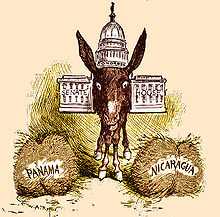Voting paradox
The voting paradox (also known as Condorcet's paradox or the paradox of voting) is a situation noted by the Marquis de Condorcet in the late 18th century, in which collective preferences can be cyclic (i.e., not transitive), even if the preferences of individual voters are not. This is paradoxical, because it means that majority wishes can be in conflict with each other. When this occurs, it is because the conflicting majorities are each made up of different groups of individuals.
For example, suppose we have three candidates, A, B, and C, and that there are three voters with preferences as follows (candidates being listed in decreasing order of preference):
| Voter | First preference | Second preference | Third preference |
|---|---|---|---|
| Voter 1 | A | B | C |
| Voter 2 | B | C | A |
| Voter 3 | C | A | B |
If C is chosen as the winner, it can be argued that B should win instead, since two voters (1 and 2) prefer B to C and only one voter (3) prefers C to B. However, by the same argument A is preferred to B, and C is preferred to A, by a margin of two to one on each occasion. The requirement of majority rule then provides no clear winner.
Also, if an election were held with the above three voters as the only participants, nobody would win under majority rule, as it would result in a three way tie with each candidate getting one vote.
When a Condorcet method is used to determine an election, a voting paradox among the ballots can mean that the election has no Condorcet winner. The several variants of the Condorcet method differ on how they resolve such ambiguities when they arise to determine a winner. Note that there is no fair and deterministic resolution to this trivial example because each candidate is in an exactly symmetrical situation.
See also
- Arrow's impossibility theorem
- Discursive dilemma
- Gibbard–Satterthwaite theorem
- Independence of irrelevant alternatives
- Instant-runoff voting
- Kenneth Arrow, Section 1 with an example of a distributional difficulty of intransitivity + majority rule
- Nakamura number
- Smith set
| ||||||||
